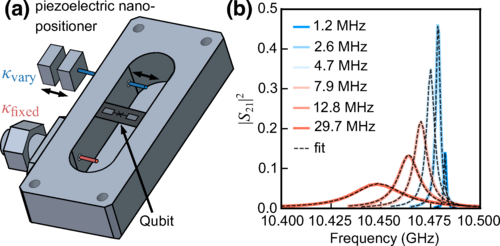Researchers from the Institute of Science and Technology Austria, the Institute for Quantum Science and Technology University of Calgary, and HUNREN Wigner RCP have made significant strides in understanding quantum phase transitions. They observed a system’s behavior becoming increasingly macroscopic as a function of the coupling strength to bandwidth ratio, which could have implications for quantum sensing and metrology. The study also contributes to the broader understanding of quantum systems, potentially leading to the development of new quantum technologies. The research represents a significant step forward in our understanding of quantum phase transitions and the behavior of quantum systems.
What is the Emergent Macroscopic Bistability Induced by a Single Superconducting Qubit?
A team of researchers, including Riya Sett, Farid Hassani, Duc Phan, Shabir Barzanjeh, Andras Vukics, and Johannes M Fink, from the Institute of Science and Technology Austria, the Institute for Quantum Science and Technology University of Calgary, and HUNREN Wigner RCP, have published a study on the emergent macroscopic bistability induced by a single superconducting qubit. The study focuses on the photon blockade breakdown in a continuously driven cavity QED system, which has been proposed as a prime example for a first-order driven-dissipative quantum phase transition.
The researchers coupled a single transmon qubit with a fixed coupling strength to a superconducting cavity that is in situ bandwidth tunable to controllably approach this thermodynamic limit. They observed the system’s behavior becoming increasingly macroscopic as a function of the coupling strength to bandwidth ratio. For the highest realized ratio, the system switches between a bright coherent state with approximately 8,000 intracavity photons and the vacuum state. This exceeds the microscopic timescales by six orders of magnitude and approaches the perfect hysteresis expected between two macroscopic attractors in the thermodynamic limit.
The findings and interpretation are qualitatively supported by neoclassical theory and large-scale quantum-jump Monte Carlo simulations. The system might also find applications in quantum sensing and metrology.
What is the Significance of Quantum Phase Transitions?
Quantum phase transitions (QPTs), both first order and second order, have been at the forefront of physics research for half a century. The original idea of QPTs as abrupt shifts in the pure ground state of closed quantum systems as a function of a control parameter applied mostly to condensed matter physics. Dissipative quantum phase transitions (DPTs) occurring in the in general mixed steady state of open quantum systems broadened the scope of phase transitions to encompass mesoscopic systems and later even microscopic systems where the interaction with the environment essentially affects the system dynamics.
A DPT was first realized experimentally in a Bose-Einstein condensate interacting with a single-mode optical cavity field and DPTs are increasingly relevant to today’s quantum science and technology. In recent years, another phase-transition paradigm could emerge, namely first-order dissipative quantum phase transitions. A first-order phase transition means that two phases can coexist in a certain parameter region, such as water and ice at 0C for a certain range of free energy.
What are the Applications of First-Order Dissipative Quantum Phase Transitions?
First-order dissipative quantum phase transitions have been found in various systems. One such platform is the clustering of Rydberg atoms described by Ising-type spin models and realized experimentally. Various other systems of ultracold atoms and dissipative Dicke-like models also exhibit signatures of a first-order DPT. Other platforms include arrays of nonlinear photonic or polaritonic modes, exciton-polariton condensates, and circuit QED.
In this work, the researchers observe and model the scaling and phase diagram of a first-order DPT in zero dimensions, i.e., for a single qubit strongly coupled to a single cavity mode. This could have significant implications for the development of quantum technologies, as it provides a new way to control and manipulate quantum systems.
What is the Photon Blockade Breakdown?
The Jaynes-Cummings (JC) model, one of the most important models in quantum science, describes the interaction between atoms and photons trapped in a cavity. This model yields the prototype of an anharmonic spectrum in the strong-coupling regime as demonstrated in cavity QED and circuit QED and with quantum dots in semiconductor microcavities. Its strong anharmonicity at the single-photon level is the basis of the photon blockade effect, in analogy with Coulomb blockade in quantum dots or with polariton blockade.
Photon blockade means that an excitation cannot enter the JC system from a drive tuned in resonance with the bare resonator frequency or similarly a second excitation from a drive tuned to resonance with one of the single-excitation levels cannot enter the JC system. This blockade can be broken by strong-enough driving due to a combination of multiphoton events and photon-number-induced shifts.
What are the Implications of this Research?
The research conducted by the team has significant implications for the field of quantum physics and technology. The observation of the system’s behavior becoming increasingly macroscopic as a function of the coupling strength to bandwidth ratio provides valuable insights into the nature of quantum phase transitions.
The findings also have potential applications in quantum sensing and metrology, which could revolutionize fields such as telecommunications, computing, and navigation. The research also contributes to the broader understanding of quantum systems, which could lead to the development of new quantum technologies.
In conclusion, the study represents a significant step forward in our understanding of quantum phase transitions and the behavior of quantum systems, with potential applications in various technological fields.
Publication details: “Emergent Macroscopic Bistability Induced by a Single Superconducting Qubit”
Publication Date: 2024-02-16
Authors: Riya Sett, Farid Hassani, D. Phan, Shabir Barzanjeh et al.
Source: PRX quantum
DOI: https://doi.org/10.1103/prxquantum.5.010327

